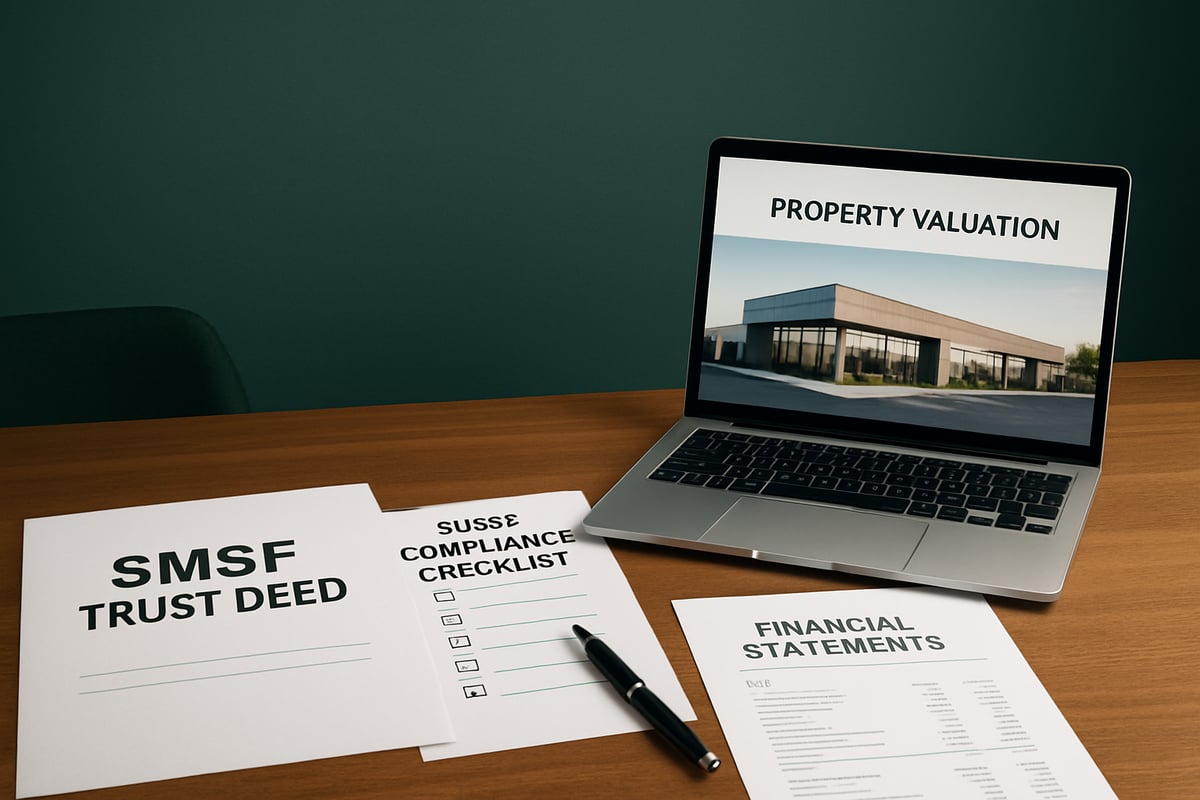Are you curious about how an smsf commercial property loan could elevate your retirement savings in 2025? With more Australians exploring new ways to invest for the future, SMSFs are opening doors to commercial property that were once out of reach.
This guide breaks down everything you need to know about an smsf commercial property loan. You’ll discover the latest rules, benefits, and risks, along with practical steps for securing and managing your loan.
Ready to unlock new wealth-building strategies? Let’s dive in and explore how an smsf commercial property loan can transform your investment journey.
Understanding SMSF Commercial Property Loans
Are you curious about how an smsf commercial property loan can help you invest in business real estate for your retirement? This section unlocks everything you need to know, from what these loans are to the latest rules and opportunities shaping the landscape in 2025.

What is an SMSF Commercial Property Loan?
A Self-Managed Super Fund (SMSF) gives investors direct control over their retirement savings, including the power to invest in property. An smsf commercial property loan lets your SMSF borrow money to purchase business-related real estate, such as offices or warehouses. Unlike residential SMSF loans, these are strictly for commercial purposes. With lenders like Liberty, you can borrow up to 80% of the property value. The loan uses a Limited Recourse Borrowing Arrangement (LRBA), which means only the property can be claimed if repayments are missed. All rental income and capital growth flow directly into the SMSF for your retirement. For more details, visit SMSF loans for commercial property.
Key Benefits of SMSF Commercial Property Loans
Choosing an smsf commercial property loan offers unique advantages for investors. First, rental income is taxed at just 15%, and in the pension phase, it can be tax-free. Over time, you can benefit from capital growth and steady rental yields. Business owners can even lease the property back to their own business at market rates, turning rent payments into retirement savings. This approach diversifies your SMSF portfolio beyond shares and cash, giving you more control and flexibility. For example, a business owner who buys their premises with an SMSF can reduce outgoing rent and build long-term wealth.
Risks and Considerations
While an smsf commercial property loan can be rewarding, it comes with risks that require careful management. The rules are complex, and compliance is strict. Since the loan is limited recourse, the lender can only claim the property if the SMSF defaults. Over-investing in property may reduce fund liquidity and diversification. Costs can be higher than standard loans, with setup, ongoing fees, and interest rates often above 6.90% per annum. Property market fluctuations can also impact your SMSF’s balance. Imagine an SMSF that borrows too much and struggles with repayments—this can lead to financial stress and possible penalties.
Types of Commercial Properties You Can Buy
With an smsf commercial property loan, your SMSF can purchase a range of income-producing properties:
| Property Type | Example Use |
|---|---|
| Offices | Corporate headquarters |
| Warehouses | Logistics and storage |
| Factories | Manufacturing |
| Retail spaces | Shops, showrooms |
| Medical suites | Clinics, dental practices |
All properties must serve a business purpose and comply with superannuation law. Residential property is not permitted under a commercial SMSF loan. For example, a doctor can use their SMSF to buy a clinic. Remember, related party transactions must always be at arm’s length to meet ATO requirements.
2025 Regulatory and Market Updates
The landscape for smsf commercial property loan products is evolving in 2025. The ATO has introduced several updates, including new documentation standards and stricter compliance reporting. Some lenders are raising borrowing limits or easing contribution rules, making it easier for SMSFs to access finance. More banks and specialist lenders are entering the market, offering greater choice. Interest rates remain a key consideration, with many experts predicting continued volatility. Industry data suggests SMSF property investment is on the rise, reflecting growing confidence and opportunity for Australian investors in the coming year.
Eligibility and Requirements for SMSF Commercial Property Loans
Navigating the eligibility and requirements for an smsf commercial property loan is crucial before starting your investment journey. Understanding what lenders and regulators look for can make the difference between a smooth approval and costly delays. Let's break down each key area so you can move forward with confidence.

SMSF Structure and Compliance Essentials
To qualify for an smsf commercial property loan, your fund must be set up with a compliant trust deed that explicitly allows for property investment and borrowing. The investment strategy should clearly state the intention to invest in commercial property using borrowed funds.
Trustees must follow the sole purpose test, ensuring all actions benefit members' retirement savings. Arm’s length rules demand any property transactions reflect true market value, especially if leasing to related parties. Every transaction, from the loan setup to property lease, must be properly documented and reported to the ATO.
If an SMSF fails compliance, the consequences can be severe, including hefty penalties or even forced asset sales. For a detailed breakdown of requirements and compliance steps, see the SMSF property loan essentials guide.
Borrower and Fund Criteria
Lenders have strict benchmarks for approving an smsf commercial property loan. Most require a minimum SMSF balance of $200,000 or more to ensure the fund is viable after the purchase. A solid contribution history and steady cash flow are also vital, as lenders want to see your SMSF can handle ongoing repayments and expenses.
Trustee experience and financial literacy matter too. Lenders often look for trustees who understand SMSF regulations and property investment basics. A clean credit history and evidence of stable income (from employer contributions or business profits) further boost your chances.
For example, an SMSF with a diversified investment portfolio and a track record of compliance is more likely to secure a loan on favorable terms compared to a fund with limited assets or poor documentation.
Property and Loan Criteria
The property you wish to buy with an smsf commercial property loan must be income-producing and meet both lender and SMSF rules. Acceptable property types include offices, warehouses, factories, retail spaces, and medical suites, but residential properties are excluded.
Lenders typically cap the loan-to-value ratio (LVR) between 70% and 80%. Loan amounts usually range from $100,000 to $4,000,000, depending on the lender’s policies and your SMSF’s financial strength. The property’s condition, location, and tenant profile are all scrutinized during the loan assessment.
In many cases, lenders require a lease agreement to be in place before settlement, especially if the property will be leased to a related business. This ensures the SMSF will generate rental income from day one.
Documentation and Evidence Needed
Applying for an smsf commercial property loan requires thorough documentation. Here’s what you’ll typically need:
- SMSF trust deed and proof of ATO registration
- Current investment strategy outlining property investment and borrowing
- Recent SMSF financial statements and member balance summaries
- Contract of sale and independent property valuation
- Lease agreement, especially if renting to a related party
- Completed lender application forms and compliance checklists
Having all documents organized and up-to-date can significantly speed up the approval process and reduce the risk of delays or rejections.
Costs and Fees Overview
Understanding the costs tied to an smsf commercial property loan helps you budget accurately and avoid surprises. Here’s a breakdown of typical fees:
| Fee Type | Typical Amount |
|---|---|
| Application Fee | From $795 |
| Establishment Fee | From 1% of loan |
| Ongoing Fee | $30/month |
| Settlement & Valuation Fees | Varies ($500–$2,000) |
| SMSF Review/Doc Fee | From $695 |
| Legal & Accounting | Varies |
| Stamp Duty | State-based rates |
| Property Management/Insurance | Varies |
For a $1M property, upfront costs can easily reach $20,000 or more, with ongoing fees adding up each year. Proper cost planning is essential to ensure your SMSF remains compliant and financially stable throughout the investment.
Step-by-Step Guide to Securing an SMSF Commercial Property Loan in 2025
Embarking on your smsf commercial property loan journey in 2025 can feel daunting, but breaking it into clear steps makes the process manageable. Whether you’re a business owner or an investor seeking diversification, following a structured approach helps you avoid costly mistakes and unlock the full benefits of your SMSF. Here’s a detailed, actionable guide to ensure your loan application and property acquisition go smoothly.

Step 1: Assess SMSF Readiness and Define Investment Goals
Start by reviewing your SMSF’s balance, contribution history, and cash flow. Is your fund healthy enough to support a smsf commercial property loan? Make sure your investment strategy clearly allows for property and borrowing.
Set your objectives. Are you aiming for long-term capital growth, steady rental income, or do you want to buy business premises? Consult an SMSF specialist or financial adviser to check alignment with compliance rules.
By clarifying your goals early, you avoid costly detours and ensure your SMSF property investment supports your retirement plans.
Step 2: Identify Suitable Commercial Properties
Next, research commercial property markets and asset types that align with your SMSF’s needs. Consider offices, warehouses, or medical suites. Make sure each property is eligible for a smsf commercial property loan and meets both SMSF and lender requirements.
Engage a buyer’s agent or property adviser who understands SMSF rules. Evaluate locations based on tenant demand, projected yields, and growth prospects.
Identifying the right property sets the foundation for long-term SMSF success and risk management.
Step 3: Prepare SMSF and Loan Documentation
Update your SMSF trust deed and investment strategy to explicitly allow borrowing if needed. Gather recent SMSF financials, member statements, and compliance records. Obtain a property valuation and ensure all due diligence is complete.
For a smooth smsf commercial property loan application, consider following a detailed checklist like the one in Buying property with SMSF. This helps you stay organized and avoid missing any critical documents.
Pre-approval from your preferred lender can speed up the process and improve negotiation power.
Step 4: Apply for SMSF Commercial Property Loan
With documentation in hand, submit your smsf commercial property loan application to your lender. Be ready to explain your SMSF structure, demonstrate compliance, and respond quickly to queries.
Lenders will conduct a thorough credit assessment, review your SMSF’s financial strength, and re-evaluate the property. They’ll also check that your fund’s investment strategy supports the loan.
Conditional approval is typically granted, subject to property settlement and any final checks required by the lender.
Step 5: Establish Limited Recourse Borrowing Arrangement (LRBA)
To comply with superannuation law, set up a separate bare trust (also called a holding trust) to legally own the property until the loan is repaid. The LRBA ensures that if your SMSF defaults, the lender’s claim is limited to the property asset.
Appoint a corporate trustee for the bare trust if required. Double-check that your smsf commercial property loan documents limit recourse to the property only.
A simple diagram of the structure: SMSF → Bare Trust → Property can help visualize the relationship.
Step 6: Complete Settlement and Property Acquisition
Once the loan is approved and the LRBA is in place, proceed to settlement. Transfer funds from both your SMSF and the lender, finalizing the purchase in the bare trustee’s name.
Arrange insurance and property management before settlement. Ensure all legal documents are executed correctly to protect your SMSF’s compliance and interests.
Your smsf commercial property loan will officially fund the acquisition, and your SMSF can start earning rental income.
Step 7: Ongoing Compliance and Loan Management
After settlement, keep meticulous records for your SMSF. Arrange for annual audits, update lease agreements to reflect market rates (especially for related parties), and ensure regular loan repayments from your SMSF account.
Monitor the property’s financial performance and SMSF liquidity. Prepare for annual lender reviews and ATO reporting requirements to stay compliant with your smsf commercial property loan obligations.
Being proactive reduces the risk of penalties and keeps your SMSF on track for retirement goals.
Common Pitfalls and How to Avoid Them
Even experienced investors can stumble when managing a smsf commercial property loan. Common mistakes include non-compliance with SMSF or LRBA rules, over-concentration in property, or underestimating cash flow needs.
To avoid issues:
- Diversify SMSF assets beyond property.
- Maintain robust documentation and arm’s length transactions.
- Regularly review your investment strategy.
- Don’t lease property below market rates to related businesses.
Staying vigilant protects your SMSF and maximizes long-term returns.
[How Property with Superannuation Can Help You Invest in SMSF Commercial Property] (https://propertywithsuperannuation.com/)
Property with Superannuation offers tailored support for every stage of your smsf commercial property loan journey. Their experts guide you through SMSF setup, compliance, and property selection, ensuring your investment strategy and documentation are rock solid.
You’ll access a curated portfolio of SMSF-approved commercial properties and receive help structuring your loan and LRBA. This is especially valuable for business owners looking to lease property back to their own company.
Book a free strategy call to assess your eligibility and discover how to maximize your SMSF’s wealth-building potential.
Compliance, Taxation, and Regulatory Insights for 2025
Staying compliant while maximising the benefits of your smsf commercial property loan is essential in 2025. This section covers the critical compliance steps, tax advantages, new rules, professional support, and real-world case studies to help your SMSF stay on track.

SMSF Loan Compliance Checklist
Every SMSF trustee must ensure their smsf commercial property loan aligns with superannuation law. Start by confirming your SMSF trust deed and investment strategy allow for property borrowing. Keep all transactions at arm’s length, using market-value lease terms if leasing to related businesses.
Maintain detailed records for your LRBA, including loan agreements and bare trust documents. Annual SMSF audits are mandatory, so keep reports and evidence organised. The ATO’s latest compliance focus for 2025 is stricter on documentation and market-value transactions, so review your fund’s processes regularly.
Missing a compliance step can lead to severe penalties and affect your fund’s ability to use a smsf commercial property loan.
Taxation Benefits and Obligations
A smsf commercial property loan offers significant tax advantages for savvy SMSF investors. Rental income from commercial property is taxed at just 15% during the accumulation phase, dropping to 0% when the fund moves into pension phase.
After holding your property for more than 12 months, capital gains tax is discounted by one-third, and it becomes tax-free in pension phase. Loan interest and property expenses are generally deductible, reducing your SMSF’s taxable income. For commercial purchases, consider GST implications and ensure you meet all reporting obligations as a trustee.
Proper tax planning with your smsf commercial property loan can boost your fund’s long-term growth and retirement outcomes.
Regulatory Changes and Lender Policies in 2025
The regulatory landscape for smsf commercial property loan arrangements has evolved in 2025. The ATO has introduced updated guidelines around borrowing limits, contribution caps, and documentation. Lenders are tightening policies, focusing more on SMSF liquidity, minimum balances, and thorough compliance checks.
Interest rate trends are also impacting SMSF borrowing, with many lenders adjusting their risk profiles. For a detailed breakdown of these updates and their implications, see the 2025 SMSF Property Rules Update.
Staying informed about these changes is crucial to securing and managing your smsf commercial property loan successfully.
Working with Advisers and Professionals
Engaging the right professionals is vital for SMSF trustees managing a smsf commercial property loan. An SMSF specialist can help you navigate compliance, structure your loan, and optimise your investment strategy. Accountants and legal advisers play key roles in ensuring correct documentation and ongoing fund compliance.
When choosing an adviser, look for proven SMSF expertise and property experience. If you want to strengthen your investment strategy, check out these SMSF investment strategy tips for actionable guidance.
Reliable professional support can be the difference between SMSF success and costly mistakes with your smsf commercial property loan.
Case Studies: Successful SMSF Commercial Property Investments
Real-world examples bring the benefits and risks of a smsf commercial property loan into focus. One business owner used their SMSF to buy office premises, leasing them back to their own company at market rates, which reduced rental expenses and grew their fund’s value.
Another SMSF diversified by acquiring a warehouse, generating steady rental yield for retirement savings. Some investors leveraged their smsf commercial property loan to accelerate wealth, but those who ignored compliance faced penalties.
Learning from these cases helps new investors make informed decisions and avoid common pitfalls with their smsf commercial property loan.
Expert Tips and Strategies for Maximising SMSF Commercial Property Loan Success
Unlocking the full potential of your smsf commercial property loan means going beyond the basics. Expert strategies can help you identify prime opportunities, structure your loan for long-term success, and steer clear of common traps. Let’s dive into four proven tactics to maximise your SMSF’s property investment outcome.
Choosing the Right Property and Location
To get the best results from your smsf commercial property loan, start by targeting commercial sectors with strong demand. Medical suites, logistics hubs, and professional office spaces are often resilient choices. Evaluate suburbs with population growth, new infrastructure, and a history of high tenant demand.
Reviewing Trends in SMSF Property Investment can highlight which property types are performing well in 2025. Prioritise quality tenants with long-term leases, as stable income is crucial for SMSF sustainability. Engage property advisers who understand SMSF rules and compliance for added peace of mind.
Loan Structuring and Risk Management
A well-structured smsf commercial property loan balances opportunity with security. Aim for a loan-to-value ratio (LVR) that keeps your SMSF’s risk in check—typically between 70% and 80%. Weigh the pros and cons of fixed versus variable rates based on market conditions.
If you want to secure a competitive rate, review the SMSF Commercial Loan Interest Rates Analysis for insights into current market offers. Maintain a liquidity buffer within your SMSF to handle repayments and unexpected costs, and diversify your fund’s assets to avoid overexposure to property.
Tax Planning and Exit Strategies
Optimising the tax benefits of your smsf commercial property loan requires forward planning. Transitioning your SMSF to pension phase allows rental income and capital gains to become tax-free. Hold properties for at least 12 months to access capital gains tax discounts.
Consider your exit options early, whether that’s selling the property, refinancing, or transferring it to members in retirement. Consult a professional SMSF tax adviser to structure your fund for maximum efficiency and ensure you capture all available deductions.
Avoiding Common Mistakes and Ensuring Longevity
Many investors stumble by neglecting compliance or failing to revisit their investment strategy. Regularly review your SMSF’s objectives and ensure every transaction meets arm’s length requirements. Keep impeccable records and stay informed about regulatory updates impacting your smsf commercial property loan.
Avoid concentrating too much of your fund in a single property. Ongoing education for trustees and engagement with SMSF specialists can help you sidestep costly errors and build lasting retirement wealth.
You have seen how SMSF commercial property loans can open up fresh opportunities for building your retirement wealth, especially with the latest rules and strategies for 2025. If you are ready to take control of your super and want to explore investment properties that truly fit your goals, we are here to help. Whether you are a business owner aiming to buy your own premises or simply looking to diversify and maximise your super, you do not have to navigate it alone.
Start Building Your Wealth—Speak With an Expert




